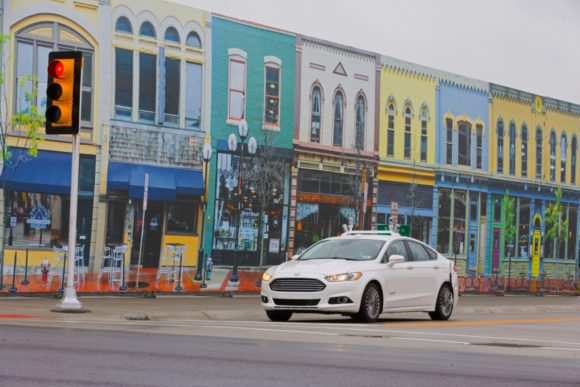The Trump administration will alter the course set by the Obama administration on autonomous vehicle policy after industry raised concerns about elements of that initial proposal.
The revised guidance — to be unveiled Tuesday in Michigan by Transportation Secretary Elaine Chao — drops a proposal issued under President Barack Obama that considered new powers for federal safety regulators to police automated vehicle safety, according to a person familiar with the matter. Several companies objected to the expanded authority, such as the ability to approve or reject a self-driving vehicle system before it could be sold. The National Highway Traffic Safety Administration lacks that authority now.
The changes come as part of the administration of President Donald Trump’s first formal statement on autonomous vehicles. Despite the shifts in direction, the policy will largely continue the Obama administration’s efforts to expand the testing and review of autonomous vehicles, the person said.
“I don’t expect this to be a sea change,” Marc Scribner, a senior fellow at the Competitive Enterprise Institute, a Washington research group that supports free-market approaches. “It will be in line with previous comments from Secretary Chao that they will be approaching this with a light regulatory touch.”
The policy is set to be released on the same day federal safety regulators will meet to consider the causes of a 2016 fatal crash involving Tesla Inc.’s auto-driving system.
Chao will announce the changes at an event at a mock town built by the University of Michigan in Ann Arbor where companies can test self-driving cars. She will also recommend that states should defer safety or performance rules to federal regulators, and will recommend that states focus on traditional issues like licensing, liability and insurance, two people familiar with the announcement said.
Revised Guidance
The revised guidance still highlights several vehicle design and safety elements that automakers should consider for automated driving systems, and describes a safety assessment letter that companies may submit to regulators documenting their approach, according to two people familiar with the matter.
Similar components were in the original Federal Automated Vehicles Policy released a year ago by NHTSA, a sign that Trump’s team plans to continue the government’s basic posture on self-driving cars. The Obama-era policy stopped short of calling for new regulations, but it did lay ground rules for how companies should approach safety. That guidance was also intended to be updated at least annually as the technology progresses.
While the Obama guidance covered Level 2 automated driving systems such as Tesla’s AutoPilot, the revised guidance will apply to so-called Level 3 automated systems or higher, which allow for less intervention from the driver, one person said. It also alters data sharing and privacy elements of the original policy, one of the people familiar said.
Elliot Katz, a partner at McGuireWoods LLP who leads the firm’s automated vehicle practice, said the revisions will likely stress the need for consumer education on autonomous vehicles, which Chao has called for before.
The agency’s stance may soon be overshadowed by legislation advancing on Capitol Hill to speed autonomous vehicle testing and deployment. Senators released draft text of legislation on Friday, just days after House lawmakers unanimously passed a bill of their own. The House version mandates that companies submit assessments of autonomous vehicle safety patterned on NHTSA guidelines. The Senate draft requires companies to submit a report describing how developers are addressing safety.
“While these guidelines are important, they’re not as transformational as the Self Drive Act could be or the bill we have coming out of the Senate could be,” Katz said.
Related:
- Automakers Seek Changes to Federal Autonomous Vehicle Guidelines
- Regulators Under Pressure to Develop Rules of Road Minus Drivers
- U.S. Autonomous Vehicle Policy Attempts to Straddle Lanes of Safety and Innovation
- House Unanimously Passes Bill to Ease Deployment of Self-Driving Cars
Topics Auto Legislation Personal Auto Politics
Was this article valuable?
Here are more articles you may enjoy.



 Kansas Man Sentenced to Probation for Insurance Fraud
Kansas Man Sentenced to Probation for Insurance Fraud  High-Net-Worth Risk Appetite Drops as Some Regions Show Stabilization
High-Net-Worth Risk Appetite Drops as Some Regions Show Stabilization  Howden Buys M&A Insurance Broker Atlantic Group in US Expansion
Howden Buys M&A Insurance Broker Atlantic Group in US Expansion  Disney Worker Injured Trying to Stop Runaway Boulder at Indiana Jones Show
Disney Worker Injured Trying to Stop Runaway Boulder at Indiana Jones Show 

